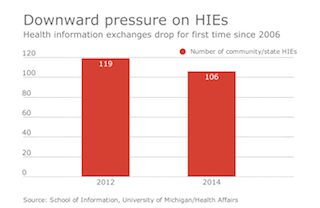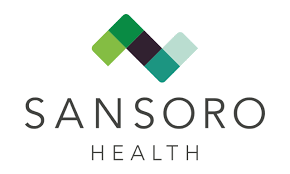Argonaut Project
See the following -
Connecting Patient Data Solving Healthcare Interoperability and the ONC Blockchain Challenge
 Interoperability is an old concept dating back to the eighth century BC. Society has been struggling for centuries with the idea of combining individual parts or components to create a whole unit. However, interoperability with healthcare only came about in published works 23 years ago, in 1993. More recently, in 2013, HIMSS defined of healthcare interoperability as “the ability of different information technology systems and software applications to communicate, exchange data and use the information that has been exchanged”...
Interoperability is an old concept dating back to the eighth century BC. Society has been struggling for centuries with the idea of combining individual parts or components to create a whole unit. However, interoperability with healthcare only came about in published works 23 years ago, in 1993. More recently, in 2013, HIMSS defined of healthcare interoperability as “the ability of different information technology systems and software applications to communicate, exchange data and use the information that has been exchanged”...
- Login to post comments
Epic and Other EHR Vendors Caught in Dilemmas by APIs (Part 1 of 2)
The HITECH act of 2009 (part of the American Recovery and Reinvestment Act) gave an unprecedented boost to an obscure corner of the IT industry that produced electronic health records. For the next eight years they were given the opportunity to bring health care into the 21st century and implement common-sense reforms in data sharing and analytics. They largely squandered this opportunity, amassing hundreds of millions of dollars while watching health care costs ascend into the stratosphere, and preening themselves over modest improvements in their poorly functioning systems...
- Login to post comments
Halamka Evaluates Blockchain for Health Information Exchange
Yesterday, I read a New York Times article about a possible successor to Bitcoin called  Ethereum, which provides a distributed database (no central repository) for the purpose of tracking financial transactions. I immediately thought of the challenge we have turning silos of medical information into a linked, complete, accurate, secure, lifetime medical record. Might blockchain technology be useful in healthcare? I posted the question to my colleagues, Arien Malec (VP, Data Platform and Acquisition Tools at RelayHealth and the new Chair of the HIT Standards Committee) and David McCallie (SVP of Medical Informatics at Cerner).
Ethereum, which provides a distributed database (no central repository) for the purpose of tracking financial transactions. I immediately thought of the challenge we have turning silos of medical information into a linked, complete, accurate, secure, lifetime medical record. Might blockchain technology be useful in healthcare? I posted the question to my colleagues, Arien Malec (VP, Data Platform and Acquisition Tools at RelayHealth and the new Chair of the HIT Standards Committee) and David McCallie (SVP of Medical Informatics at Cerner).
- Login to post comments
Halamka on MU3 Regs: The Good, The Bad, and the Ugly
 On Friday March 20, CMS released the Electronic Health Record Incentive Program-Stage 3 and ONC released the 2015 Edition Health Information Technology (Health IT) Certification Criteria, 2015 Edition Base Electronic Health Record (EHR) Definition, and ONC Health IT Certification Program Modifications. Perhaps the most important statement in the entire 700+ pages is the following from the CMS rule: "Stage 3 of meaningful use is expected to be the final stage and would incorporate portions of the prior stages into its requirements."
On Friday March 20, CMS released the Electronic Health Record Incentive Program-Stage 3 and ONC released the 2015 Edition Health Information Technology (Health IT) Certification Criteria, 2015 Edition Base Electronic Health Record (EHR) Definition, and ONC Health IT Certification Program Modifications. Perhaps the most important statement in the entire 700+ pages is the following from the CMS rule: "Stage 3 of meaningful use is expected to be the final stage and would incorporate portions of the prior stages into its requirements."
- Login to post comments
Halamka Summarizes the CMS Meaningful Use Final Rule
 I’ve been asked to summarize the 752 page CMS Meaningful Use Final Rule...Between the Notice of Proposed Rulemaking and the publication of the CMS Final Rule, the Medicare Access and CHIP Reauthorization Act of 2015 (MACRA) passed to include sunsetting the Meaningful Use payment adjustment for professionals at the end of 2018. Also, MACRA requires the establishment of a Merit-Based Incentive Payment System (MIPS) which would incorporate Meaningful Use. The comment period will be used in an attempt to align the Meaningful Use program and the MIPS program...Stage 3 is more controversial and I will focus on that.
I’ve been asked to summarize the 752 page CMS Meaningful Use Final Rule...Between the Notice of Proposed Rulemaking and the publication of the CMS Final Rule, the Medicare Access and CHIP Reauthorization Act of 2015 (MACRA) passed to include sunsetting the Meaningful Use payment adjustment for professionals at the end of 2018. Also, MACRA requires the establishment of a Merit-Based Incentive Payment System (MIPS) which would incorporate Meaningful Use. The comment period will be used in an attempt to align the Meaningful Use program and the MIPS program...Stage 3 is more controversial and I will focus on that.
- Login to post comments
Halamka's 2016 Predictions for Health IT
 As the year ends and we archive the accomplishments and challenges of 2015, it’s time to think about the year ahead. Will innovative products and services be social, mobile, analytics, and cloud (SMAC)? Will wearables take off? Will clinicians be replaced by Watson? Here are my predictions...Apps will layer on top of transactional systems empowered by FHIR...a better approach is crowdsourcing among clinicians that will result in value-added apps that connect to underlying EHRs via the protocols suggested in the Argonaut Project (FHIR/OAuth/REST). One of our clinicians has already authored a vendor neutral DICOM viewer for images, a patient controlled telehealth app for connecting home devices, and a secure clinical photography upload that bypasses the iPhone camera roll. That’s the future.
As the year ends and we archive the accomplishments and challenges of 2015, it’s time to think about the year ahead. Will innovative products and services be social, mobile, analytics, and cloud (SMAC)? Will wearables take off? Will clinicians be replaced by Watson? Here are my predictions...Apps will layer on top of transactional systems empowered by FHIR...a better approach is crowdsourcing among clinicians that will result in value-added apps that connect to underlying EHRs via the protocols suggested in the Argonaut Project (FHIR/OAuth/REST). One of our clinicians has already authored a vendor neutral DICOM viewer for images, a patient controlled telehealth app for connecting home devices, and a secure clinical photography upload that bypasses the iPhone camera roll. That’s the future.
- Login to post comments
Halamka's Report on the June 2015 HIT Standards Committee
 The June 2015 HIT Standards Committee focused on celebrating the accomplishments of those individuals who have reached their federal advisory committee term limits. Most served 6 years...Karen DeSalvo thanked each one and I offered comments about their unique contributions, changing the fundamental trajectory of standards in the US from a 1990’s “EDI” payload model to a 2015 “Facebook” Application Program Interface model. Their leadership has brought modern, open web standards to the healthcare domain, specified controlled vocabularies, and established appropriate security. They will be missed.
The June 2015 HIT Standards Committee focused on celebrating the accomplishments of those individuals who have reached their federal advisory committee term limits. Most served 6 years...Karen DeSalvo thanked each one and I offered comments about their unique contributions, changing the fundamental trajectory of standards in the US from a 1990’s “EDI” payload model to a 2015 “Facebook” Application Program Interface model. Their leadership has brought modern, open web standards to the healthcare domain, specified controlled vocabularies, and established appropriate security. They will be missed.
- Login to post comments
Halamka: What is the Optimal Future Role for ONC?
 As Meaningful Use winds down and incentive dollars are fully spent, what is the optimal role for ONC going forward? Some pundits have suggested that ONC step aside and return all aspects of HIT policy and technology to the private sector. Others have suggested top down command and control of HIT including centralized governance to ensure interoperability. Harmony is when all parties feel equally good about the path forward. Compromise is when everyone leaves the table equally unhappy. Here’s my view about the future of ONC that includes points from both sides.
As Meaningful Use winds down and incentive dollars are fully spent, what is the optimal role for ONC going forward? Some pundits have suggested that ONC step aside and return all aspects of HIT policy and technology to the private sector. Others have suggested top down command and control of HIT including centralized governance to ensure interoperability. Harmony is when all parties feel equally good about the path forward. Compromise is when everyone leaves the table equally unhappy. Here’s my view about the future of ONC that includes points from both sides.
- Login to post comments
HL7 Chief Charles Jaffe to Update on FHIR Argonaut Project Progress at HIMSS16
 More than a year after its implementation, Charles Jaffe, MD, CEO of HL7, is scheduled to return to the HIMSS Annual Conference to update the industry on the accomplishments to date and shed light on developments coming in the near future. HL7 launched the Argonaut Project in collaboration with healthcare IT vendors and providers to accelerate the adoption of Fast Healthcare Interoperability Resources and, according to Jaffe, there are several exciting developments to discuss...
More than a year after its implementation, Charles Jaffe, MD, CEO of HL7, is scheduled to return to the HIMSS Annual Conference to update the industry on the accomplishments to date and shed light on developments coming in the near future. HL7 launched the Argonaut Project in collaboration with healthcare IT vendors and providers to accelerate the adoption of Fast Healthcare Interoperability Resources and, according to Jaffe, there are several exciting developments to discuss...
- Login to post comments
HL7 Launches Joint Argonaut Project to Advance FHIR
Leading Health IT industry vendors and providers collaborate with HL7 to accelerate development and adoption of FHIR Read More »
- Login to post comments
Microsoft, Amazon, Google, IBM, Oracle, and Salesforce Issue Joint Statement Making Commitment to Open Source Healthcare Interoperability
 Interoperability is an overlapping set of technical and policy challenges, from data access to common data models to information exchange to workflow integration – and these challenges often pose a barrier to healthcare innovation. Microsoft has been engaged for many years on developing best practices for interoperability across industries. Today, as health IT community leaders get together at the CMS Blue Button 2.0 Developer Conference here in Washington, DC, we’re pleased to announce that Microsoft has joined with Amazon, Google, IBM, Oracle, and Salesforce in support of healthcare interoperability...
Interoperability is an overlapping set of technical and policy challenges, from data access to common data models to information exchange to workflow integration – and these challenges often pose a barrier to healthcare innovation. Microsoft has been engaged for many years on developing best practices for interoperability across industries. Today, as health IT community leaders get together at the CMS Blue Button 2.0 Developer Conference here in Washington, DC, we’re pleased to announce that Microsoft has joined with Amazon, Google, IBM, Oracle, and Salesforce in support of healthcare interoperability...
- Login to post comments
Navigating between Heavy-weight and Light-weight Standardization
 Andy Oram
Andy Oram
FHIR is large and far-reaching but deliberately open-ended. Many details are expected tovary from country to country and industry to industry, and thus are left up to extensions that various players will design later. It is precisely in the extensions that the risk lurks of reproducing the Tower of Babel that exists in other health care standards. The reason the industry have good hopes for success this time is the unusual way in which the Argonaut project was limited in both time and scope. It was not supposed to cover the entire health field, as standards such as the International Classification of Diseases (ICD) try to do. It would instead harmonize the 90% of cases seen most often in the US. For instance, instead of specifying a standard of 10,000 codes, it might pick out the 500 that the doctor is most likely to see.
- Login to post comments
Number of Public HIEs Drop, Bringing Viability into Question
 Despite federal funding that aided their creation, the number of community and state health information exchanges is declining as HIEs struggle to remain financially viable now that seed money has dried up. Those are among the results of a new national survey published in the July issue of Health Affairs that tracked community and state HIE efforts soon after federal funding ended. “We found 106 operational HIE efforts that, as a group, engaged more than one-third of all U.S. providers in 2014,” states the study’s authors...
Despite federal funding that aided their creation, the number of community and state health information exchanges is declining as HIEs struggle to remain financially viable now that seed money has dried up. Those are among the results of a new national survey published in the July issue of Health Affairs that tracked community and state HIE efforts soon after federal funding ended. “We found 106 operational HIE efforts that, as a group, engaged more than one-third of all U.S. providers in 2014,” states the study’s authors...
- Login to post comments
Obama Administration Announces Key Actions to Accelerate Precision Medicine Initiative
 A year ago the President announced the launch of the Precision Medicine Initiative to accelerate a new era of medicine that delivers the right treatment at the right time to the right person, taking into account individuals’ health history, genes, environments, and lifestyles. Precision medicine is already transforming the way diseases like cancer and mental health conditions are treated. Molecular testing for cancer patients lets physicians and patients select treatments that improve chances of survival and reduce adverse effects...
A year ago the President announced the launch of the Precision Medicine Initiative to accelerate a new era of medicine that delivers the right treatment at the right time to the right person, taking into account individuals’ health history, genes, environments, and lifestyles. Precision medicine is already transforming the way diseases like cancer and mental health conditions are treated. Molecular testing for cancer patients lets physicians and patients select treatments that improve chances of survival and reduce adverse effects...
- Login to post comments
Sansoro Health Record API Will Unite Them All
 After some seven years of watching the US government push interoperability among health records, and hearing how far we are from achieving it, I assumed that fundamental divergences among electronic health records at different sites posed problems of staggering complexity. I pricked up my ears, therefore, when John Orosco, CTO of Sansoro Health, said that they could get EHRs to expose real-time web services in a few hours, or at most a couple days.
After some seven years of watching the US government push interoperability among health records, and hearing how far we are from achieving it, I assumed that fundamental divergences among electronic health records at different sites posed problems of staggering complexity. I pricked up my ears, therefore, when John Orosco, CTO of Sansoro Health, said that they could get EHRs to expose real-time web services in a few hours, or at most a couple days.
- Login to post comments